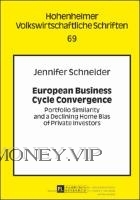
A. Introduction
1. Motivation
One issue for currency areas such as the European Monetary Union (EMU) is
that not necessarily one size fits all, i.e. the interest rate setting of the central
bank cannot consider different states of the economy in different member countries.
A country in recession would prefer low interest rates to stimulate the economy;
whereas, for a country in boom, low interest rates might cause inflation.
As Mundell (1961) – in his fundamental work – puts it, an optimal currency
area is an economic unit that is independent from national borders. Only if all
countries taking part in the monetary union behave as an economic unit and react
similar to asymmetric shocks can a common monetary policy react. Otherwise,
contradictory signals for the interest setting might be a consequence and might
raise costs for being a member of a monetary union. Most economists agree that,
so far, the countries participating in the EMU do not have synchronised business
cycles (see e.g. Artis, 2003; Gros and Hefeker, 2004). To reduce the costs of
giving away power over monetary policy, a business cycle convergence of the
participating countries would lead to less ambiguous indicators for monetary
policy decisions.
But which factors contribute to business cycle convergence? Besides well
known factors such as trade integration or factor mobility, one factor could be
the synchronized consumption of private households in EMU member countries.
Synchronized consumption can in turn be influenced by similar private (finan-
cial) investment strategies, leading to similar returns and consumption out of
financial wealth. Financial wealth of private households has grown substantially
in recent years. In Western Europe, financial wealth amounts for over 150 % of
GDP, and the estimation of the annual growth rate of financial wealth is 4.2 %
(2002-2006) (Uni Credit Group, 2007). Further growth is expected.
The growing importance of financial wealth implies that investment deci-
sions have a growing influence on income, the standard of living – and therefore
also on consumption. Investment strategies are usually assumed to be rational,
meaning investors would reach similar investment decisions. A plausible “com-
mon” investment strategy could be the International Asset Pricing Model
(IAPM), which is based on the Capital Asset Pricing Model (CAPM) by Sharpe
(1964). According to this model, a portfolio should reflect the relative world
market weights of all countries to achieve the best risk-return-ratio (De Santis
and Gérard, 1997, p. 1881 et seqq.). This model has recently gained much atten-
tion in popular finance media which addressed the widely observed phenomenon
of home bias. Basically, home bias means investing mainly in one’s home coun-
try instead of benefitting from international diversification, e.g. in Germany,
about 83 % of the Germans invest in German companies although financial lit-
erature has been recommending diversification over different countries, asset
categories, etc. for years (Zydra, 2008). Interestingly at the same time, the Ger-
mans became more risk-averse and were selling their bonds and shares in the
aftermath of the financial crisis (Schroers, 2008) – a contradiction to the ideas of
the mentioned financial investment literature of diversification. This develop-
ment can only lead to the conclusion that investment behaviour is not necessarily
rational. Opposed to these trends, on a European basis, a declining home bias can
be observed in recent years even after the crisis.
Home bias is a phenomenon not only discussed in the financial literature but
also on a macroeconomic level, as well under the label of international risk shar-
ing. International risk sharing means that individuals hold claims on the output of
other countries to diversify their risks and achieve consumption smoothing. Con-
sumption or income smoothing can either be achieved ex ante (by holding claims
on the output of other countries over financial markets) or ex post (through either
credit channels or a federal transfer system). Whereas, in the management litera-
ture, dealing with the International Asset Pricing Model (IAPM) and home bias,
the personal advantage of individuals is stressed; the macroeconomic literature
of international risk sharing concentrates on consumption smoothing. The link
between these two directions is business cycle convergence: similar investments
lead to similar consumption and therefore to a convergence of cycles. This link
has only been simultaneously addressed in the literature in the sense of keeping
the two topics apart (Sørensen, B.E., Wu, and Zhu, 2007; Lewis, 1999).
However, the positive link of the investor position and macroeconomic di-
mension of business cycle convergence has not been discussed in the literature
yet. It is one of the tasks of the dissertation to highlight the theoretical link from
personal advantages derived by rational investment strategies to business cycle
convergence. The most important part is to investigate empirically if the theo-
retical link holds for the EMU countries. One may note that the rationality of
investment decisions is not the important factor of business cycle convergence
itself. This factor is the similarity of portfolios which result in similar income




